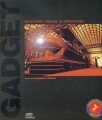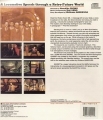Gadget: Invention, Travel & Adventure
First posted on 01 August 2007. Last updated on 10 August 2009.
At the dawn of the CD-ROM era, multimedia graphics were increasingly being incorporated into computer games. The adventure genre was seen as the most suitable medium to experiment with the possibilities of this now settled technology. Pre-rendered still images, which later integrated with animated movies, showed for the first time both the graphical and storage capabilities of the new hardware. By now, many of the games from this era have long faded away in memory. Yet, games such as The 7th Guest and Myst are still remembered as pioneers of a generation that has impressed gamers with their unique visual style. However, these games were also criticized for their gameplay that was often shallow. Many of them played more like interactive movies, or interactive slideshows, than true adventure games.
Gadget: Invention, Travel & Adventure (which, by the way, has nothing to do with the animated cartoon Inspector Gadget) is an extreme example of a game from this early era, for it is much more an interactive movie than an adventure game. Initially released in 1993 by Synergy Interactive, the game is re-released later in 1998 as a special edition by Cryo Interactive, after renaming it to Gadget: Past as Future.
The story starts in West End Hotel, room 306. You have an appointment in the lobby of the hotel with a mysterious man named Theodore Slowslop. He tells you to get in touch with a scientist with the ludicrous name Horselover Frost, the leader of a team of scientists who have been conducting secretive and puzzling experiments. Your search leads you onto a journey to different locations using various means of transport, including a futuristic looking streamlined steam locomotive. As you progress, your experience becomes more surrealistic and mysterious, including your encounter of a mute boy who turns up once in a while and hovers seemingly through the air. Other characters who you meet tell you of contradictory anecdotes of the inexplicable events surrounding you. It appears that you are being sent to fetch and assemble a number of gadgets for an enigmatic machine called the Sensorama, which is supposedly designed to help mental patients. Yet, is the machine actually a brainwashing device and are the scientists just a group of megalomaniac mad men? Eventually, you discover that the scientists are all busy designing and constructing a spaceship called the Ark, so they can get away from Earth in time, for they are all claiming there is a meteorite that will soon collide with the planet. Even after the adventure ends, it is not completely clear what is real and what is not, since you also seem to have been influenced by the Sensorama machine. The story truly grasps the imagination from beginning to end, much in the style of David Lynch' Mullholland Drive and Stanley Kubrick' 2001: A Space Odyssey.
Despite of the intricate story, there is not much of a game to be found. In fact, the game is best not to be approached as a true adventure game—even the game package claims that the game is really an interactive movie "directed" by its Japanese creator Haruhiko Shono (who, incidentally, has written a book on the making of the game, Inside Out with Gadget). Critics may ask the question as to why the game is not released as a movie but rather a video game, but since it has been released as the latter, it will always be judged in comparison with other adventure games, regardless how unfair this may seem.
As an adventure game, unfortunately, it is mediocre at best. This is a completely linear game. There is no real puzzle to be solved anywhere. For all locations in the game, the player only has to activate a trigger to continue the journey onward. The trigger is no more than talking to a character or pulling a handle. All of the triggers are extremely easy to find, since there is only a single real action that the player is expected to perform for each location. For the rest, the player is just clicking along, as if the player is looking through a huge slideshow. Even the game cursor looks like an arrow that can be seen in the slideshow. The gadgets or devices which the player gathers are automatically stored in a briefcase. This briefcase acts like a sort of non-interactive inventory. When an item is needed in a location, it is automatically activated so that it is not possible to select a wrong item. It is also not possible to return to an earlier location anytime in the game, expect when it is part of the script. Indeed, it is a relief that the story is so involving, for otherwise the game will really be too big of a bore to play. Near the end, the game unexpectedly attempts to delivers the player a puzzle—but to much disappointment—a maze. This is the only time when the player has to do some problem solving in the game.
The unique production value of this game is attributed to its surrealistic style and feel. Graphically, the game world is aptly rendered. The environments look a bit dusty, though the developer rightly claims (as on the game package) that "there wafts through it an atmosphere of nostalgia". Once the player activates a trigger to be taken to the next section, a black and white movie (all rendered in QuickTime) is almost always shown as a cut scene. The futuristic looking locomotives are featured a lot in these cut scenes. The artworks all have a touch of noire and retro look of the machine age of the 1920s and 1930s. With one exception, none of the game characters are animated or voiced. The few lines of dialogs, written by Hirokazu Nabekura, are just displayed as plain text at the bottom of the screen. Many of the game characters look very pale, as if the world is populated by zombies. The music is composed by Koji Ueno who is described (on the game package) as "a composer who combines digital sensitivity with classical training". A non-Japanese gamer who listens to the music will likely describe it as weird, though it succeeds in creating an atmosphere of suspense for the game.
Overall, Gadget: Invention, Travel & Adventure succeeds mildly as an interactive movie but fails miserably as an adventure game. The surrealistic atmosphere it manages to create is truly involving. However, the game lacks the gameplay necessary to call itself a classic adventure, since all the interaction with the player is totally limited to a simple linear clicking exercise. Without any real puzzle, the game is also very easy to finish. In the end, Gadget: Invention, Travel & Adventure is merely multimedia eye candy with a peculiar Japanese root, but otherwise a forgettable game from an era gone by.






